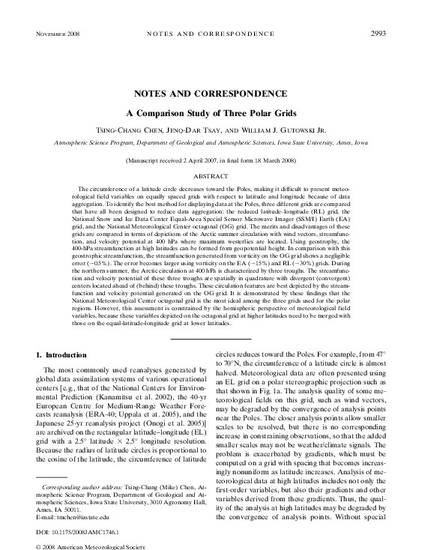
The circumference of a latitude circle decreases toward the Poles, making it difficult to present meteorological field variables on equally spaced grids with respect to latitude and longitude because of data aggregation. To identify the best method for displaying data at the Poles, three different grids are compared that have all been designed to reduce data aggregation: the reduced latitude–longitude (RL) grid, the National Snow and Ice Data Center Equal-Area Special Sensor Microwave Imager (SSM/I) Earth (EA) grid, and the National Meteorological Center octagonal (OG) grid. The merits and disadvantages of these grids are compared in terms of depictions of the Arctic summer circulation with wind vectors, streamfunction, and velocity potential at 400 hPa where maximum westerlies are located. Using geostrophy, the 400-hPa streamfunction at high latitudes can be formed from geopotential height. In comparison with this geostrophic streamfunction, the streamfunction generated from vorticity on the OG grid shows a negligible error (∼0.5%). The error becomes larger using vorticity on the EA (∼15%) and RL (∼30%) grids. During the northern summer, the Arctic circulation at 400 hPa is characterized by three troughs. The streamfunction and velocity potential of these three troughs are spatially in quadrature with divergent (convergent) centers located ahead of (behind) these troughs. These circulation features are best depicted by the streamfunction and velocity potential generated on the OG grid. It is demonstrated by these findings that the National Meteorological Center octagonal grid is the most ideal among the three grids used for the polar regions. However, this assessment is constrained by the hemispheric perspective of meteorological field variables, because these variables depicted on the octagonal grid at higher latitudes need to be merged with those on the equal-latitude-longitude grid at lower latitudes.
Available at: http://works.bepress.com/william-gutowski/6/

This article is from J. Appl. Meteor. Climatol., 47, 2993–3007. doi: http://dx.doi.org/10.1175/2008JAMC1746.1. Posted with permission.